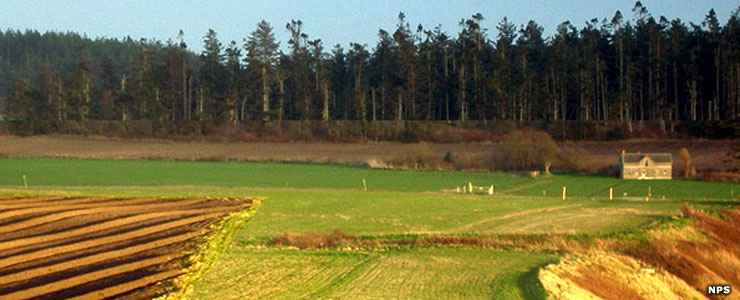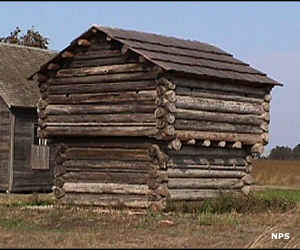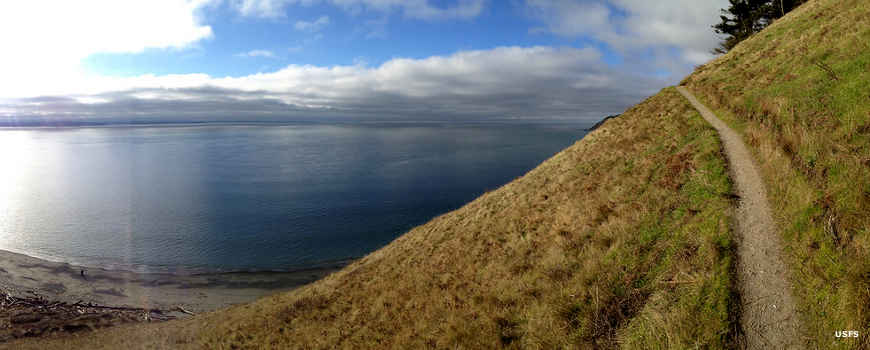Ebey's Landing National Historical Reserve

Ebeys Landing National Historical Reserve

Ebey's Blockhouse
Ebey's Landing National Historical Reserve is an unusual property. While the Reserve itself claims an acreage of 19,333 acres, only about 209 acres is federally owned. The properties included in the Reserve are a mix of federal, state, county and private property managed primarily to preserve its historical essence. Since the Ebey's Landing National Historical Reserve was first authorized in November, 1978, the property has been managed as a partnership with a local Trust Board.
What is preserved at the Ebey's Landing National Historical Reserve is an unbroken historical record of Puget Sound since the first Europeans entered the waters, explored the land and settled down to farm. Some of the farms in the Reserve have been under cultivation since the land was first claimed under the Donation Land Claim Act in the 1850's. Within the bounds of the Reserve is Coupeville, a Victorian seaport community that is one of the oldest settlements in Washington. Fort Casey and Fort Ebey State Parks are also within the Reserve.
Puget Sound was first explored by Captain George Vancouver in 1792. The name of the landing comes from one of the earliest settlers, Colonel Isaac Ebey, who became an important figure in early Washington politics and events. In 1857, coastal Indians seeking revenge for the killing of one of their own chieftains killed him.
Growth in the area was fueled by the early days of the Oregon Trail and again by later westward migration. The 1840's were a time of contention between Great Britain and the United States over competing land claims in the northwest. The primary push for the Oregon Trail was to get American citizens to settle in Oregon Territory (which included Washington in those days) to solidify American claims to that territory. Eventually it was settled with the 49th parallel being the boundary between the United States and British Canada but in 1850, to make sure, Congress passed the Donation Land Claim Act, legislation that granted 320 acres to every unmarried white male 18 years or older and 640 acres to every white married couple arriving in Oregon and registering before December 1, 1850. In the case of a married couple, this was one of the first laws in the United States that allowed married women to hold property in their own name as the 640-acre grant was made 320 acres to the husband and 320 acres to the wife. Claimants were required to live on the land and cultivate it for four years in order to get clear title and own it outright. For folks who arrived after the 1850 deadline but before 1854 there was a provision in the law whereby they could claim half that amount of land for free. After that 1854 cut-off, land was still available but it cost $1.25 per acre with a limit of 320 acres in any one claim. The original law expired on December 1, 1855 and successive installments saw the prices continually raised and maximum size of claims continually reduced. Congress passed the first Homestead Act in 1862 and as much as that had been meant specifically to encourage settlement in the Great Plains region, it applied to Oregon and Washington as well.
Another early settler was Captain Thomas Coupe, a sea captain and merchant who arrived in 1852 and quickly claimed the 320-acre parcel on the south shore of Penn Cove that is now Coupeville. Back in those early days, the success of local farming coupled with early development of maritime trade made Coupeville a dominant seaport. The town we see preserved today is a showcase of 19th century commercial buildings, Victorian residential architecture and the historic wharf and blockhouses (built to protect early settlers from the local Indians they were afraid of).
Fort Casey was built in the 1890's and eventually grew to a garrison of 400 soldiers. The fort was established as one element in a three-fort system designed to protect the depths of Puget Sound. The fort evolved into a social center for the surrounding communities on Whidbey Island but never did see any military action.
Near the northern boundary of the Reserve, Fort Ebey is a relic leftover from the military defensive buildup in World War II.
What made the area of Ebey's Landing stand out was the stunning landscape and rich farmland on Whidbey Island, the gateway to Puget Sound. The Skagit Indians had inhabited the area for hundreds of years and grown their own crops on the land. They had a method of selective burning, transplanting and mulching that encouraged the growth of crops like camas and bracken fern, long-time staples of their diet. They had also evolved a highly functional society and were engaged in trade relationships with other native peoples hundreds and thousands of miles away. There were more than 1,500 Native Americans living in the island in 1792 but by 1904, that number had been reduced to only a few small families.
Ebey's Landing National Historical Reserve is open 24/7/365 with no fees involved. However, there are some facilities on the property that do charge fees to visitors and some facilities do have limited hours. The Scenic Waysides are open daily from 8 am to dusk (no overnight parking or camping allowed). The state parks are also open daily from 8 am to dusk. The Island County Historical Museum is open daily, October through April from 10 am to 4 pm on Mondays through Saturdays and 11 am to 4 pm on Sundays. From May through September the Museum is open daily from 10 am to 5 pm. The Headquarters office for the Reserve itself is open Monday through Thursday (except for federal holidays) from 8:30 am to 4:30 pm.
The Pacific Northwest National Scenic Trail traverses Ebey's Landing east/west on its 1,200-mile journey between the Continental Divide in Glacier National Park and the Pacific Ocean.

The Pacific Northwest Trail meets Ebey's Landing National Historical Reserve
Lower photo courtesy of the US Forest Service